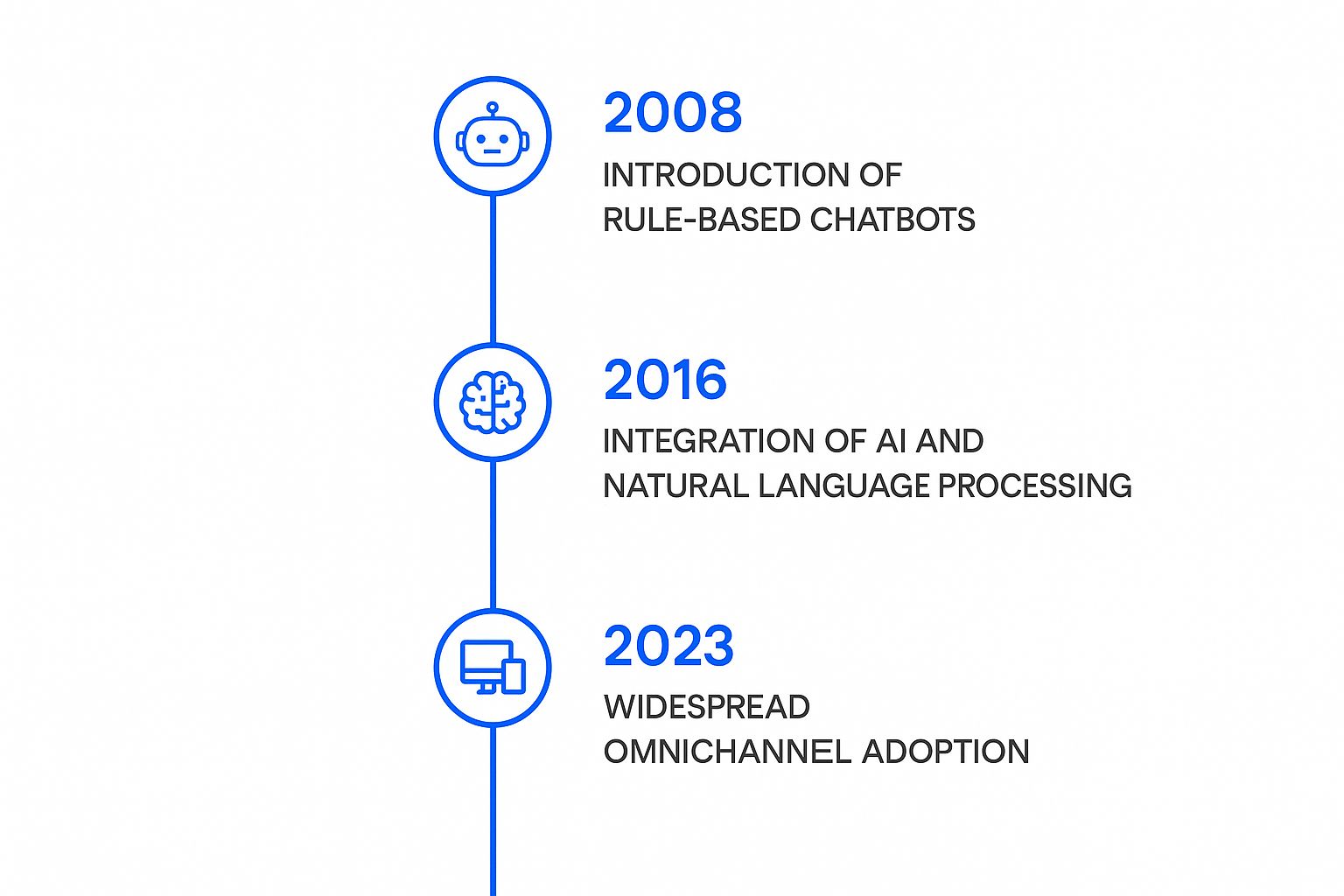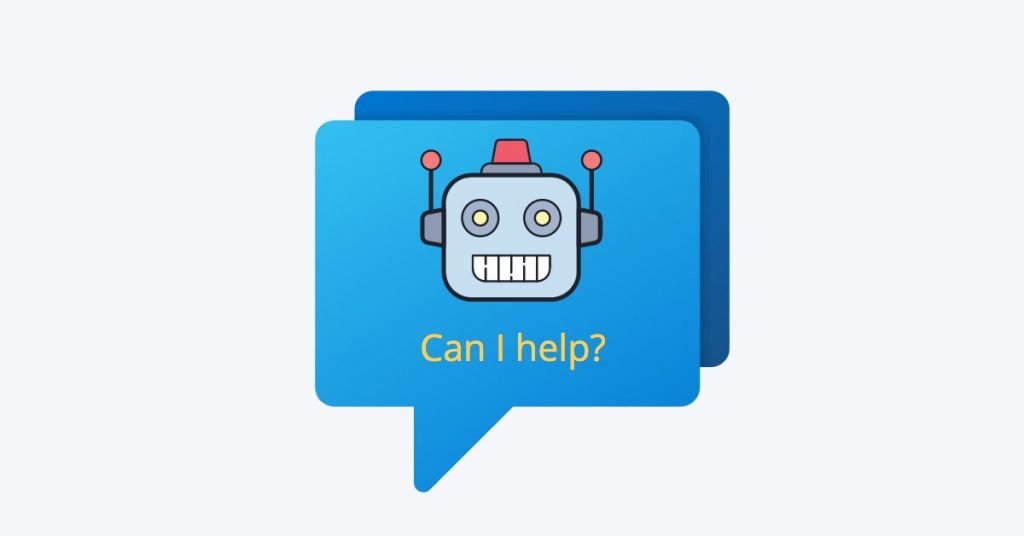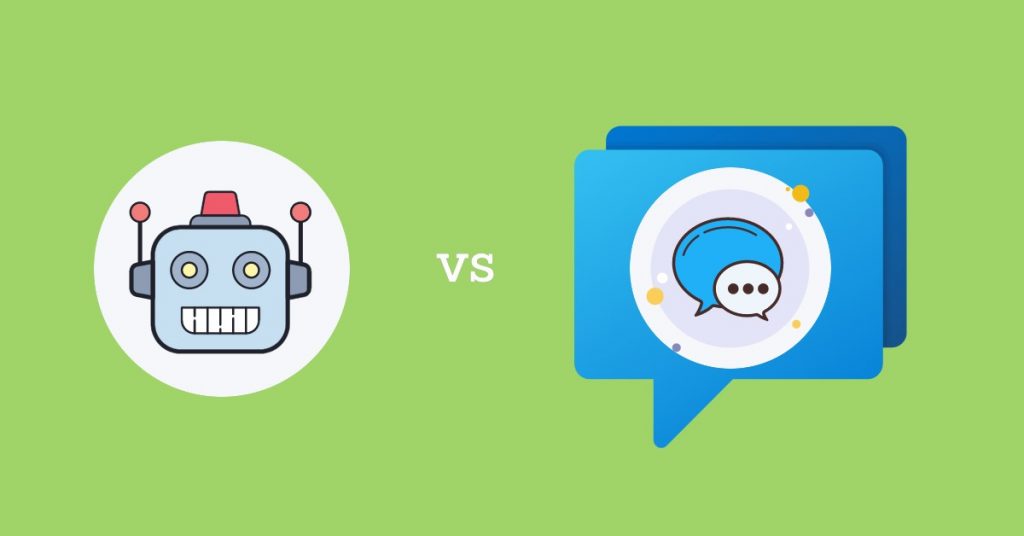The Evolution of Chatbots: From Basic Bots to CX Game-Changers
Early chatbots relied on rule-based systems, offering limited, pre-programmed responses. These first-generation bots struggled with anything beyond a narrow set of commands, often leading to frustrating customer experiences. Imagine them as a digital phone tree, guiding users down a rigid path with limited options. If a customer’s request fell outside the predefined script, the chatbot faltered, requiring human intervention.
However, the chatbots in customer service has dramatically changed. Advancements in Natural Language Processing (NLP) and Machine Learning (ML) have fueled this evolution. These technologies enable chatbots to understand and interpret human language with increasing accuracy. Modern chatbots no longer require exact keywords. Instead, they can now grasp the intent behind a customer’s message, even if phrased differently.

The infographic above illustrates key milestones in chatbot evolution, from rule-based systems in 2008 to the adoption of AI and NLP in 2016, and omnichannel integration in 2023. Each milestone builds upon previous advancements, leading to increasingly sophisticated chatbot solutions. The progress is evident.
The Rise of AI in Customer Service
The rise of AI-powered chatbots has been remarkable, signifying a shift towards automation in customer service. By 2025, AI is projected to handle 95% of customer interactions. Furthermore, 80% of companies are either using or plan to use AI-powered chatbots for customer service. This reflects the growing recognition of automation’s potential to boost support efficiency and cut costs. Find more detailed statistics here. For more information on effectively using chatbots, check out this resource: How to Master Chatbots.
The table below, “Evolution of Chatbots in Customer Service”, details the progression of chatbot capabilities and limitations over time. It offers a concise overview of each generation’s advancements.
| Generation | Time Period | Key Capabilities | Limitations |
|---|---|---|---|
| 1st | ~2008 | Basic keyword recognition, simple responses | Limited understanding, rigid scripts |
| 2nd | ~2016 | Improved NLP, contextual awareness, personalized interactions | Difficulty with complex queries, occasional misinterpretations |
| 3rd | ~2023 | Omnichannel integration, seamless handoff to human agents, sentiment analysis | Ongoing development, requires continuous training and data updates |
As the table shows, each generation of chatbots has overcome limitations of its predecessors, leading to the robust solutions available today.
The Omnichannel Advantage
Chatbots have become essential customer service tools, deployed across various channels. From websites and mobile apps to social media platforms like Facebook and messaging apps, this omnichannel presence ensures consistent support, regardless of how customers interact with a business. This represents a fundamental shift in customer interaction, emphasizing positive, engaging chatbot experiences to maximize the benefits of this technology.
The Business Case: Why Chatbots Are Transforming Support Economics

Beyond all the buzz, chatbots offer tangible value by significantly lowering customer service costs. Strategic chatbot implementation helps companies achieve substantial cost reductions, sometimes between 60-80%, for routine interactions, freeing up resources, enabling support teams to address more complex issues.
Realizing Return on Investment (ROI) with Chatbots
A major advantage of chatbots is the potential for quick ROI. Every simple question a chatbot answers is one less call or email a human agent handles. This directly lowers labor costs and boosts agent productivity. AI-powered chatbots efficiently manage tasks such as providing order statuses, answering FAQs, and guiding customers to relevant information. This efficiency allows agents to focus on more complicated issues, leading to enhanced customer experiences. Market growth reflects this value, with a projected increase of $1.43 billion by 2025, showcasing growing chatbot adoption across various industries. Explore this topic further.
Enhancing Efficiency and Customer Satisfaction (CSAT)
Chatbots don’t also improve key metrics like average handling time. Automating repetitive tasks allows chatbots to quickly resolve common customer issues, leading to faster resolutions and happier customers. Businesses often see significant CSAT score improvements after implementing chatbot solutions. Platforms like Social Intents, which integrate with tools like Microsoft Teams and Slack, streamline workflows and further enhance support team efficiency.
Reimagining Agent Roles
As chatbots handle routine inquiries, support agents can take on more strategic roles. Rather than answering basic questions, they can focus on complex problem-solving, nurturing customer relationships, and providing personalized support. This shift increases agent job satisfaction and improves customer retention. The balance of automation and the human touch is crucial for strengthening customer loyalty.
Let’s examine some ROI metrics across different industries. The following table summarizes key improvements:
ROI Metrics for Chatbot Implementation
A comparison of key business metrics before and after chatbot implementation across different industries
| Industry | Cost Reduction | Resolution Time Improvement | Customer Satisfaction Impact | Agent Productivity Increase |
|---|---|---|---|---|
| E-commerce | 70% | 60% | +20% | 45% |
| Healthcare | 55% | 40% | +15% | 30% |
| Financial Services | 65% | 50% | +25% | 40% |
| Telecommunications | 75% | 65% | +18% | 50% |
As this table reveals, chatbot implementation leads to significant improvements across various industries, demonstrating the broad applicability and benefits of this technology. These impressive results underscore the value of chatbots in optimizing support operations and driving business growth.
Creating Chatbot Experiences Your Customers Will Actually Love
Moving beyond simply automating responses, the power of a chatbot in customer service lies in crafting interactions that not only resolve issues but also create positive experiences. Understanding the psychology behind successful customer-chatbot interactions is key to designing conversations that truly resonate with your target audience. Just like choosing the right brand ambassador, your chatbot’s “personality” should align with your brand and appeal to your customer base.
Designing for Delight: The Psychology of Chatbot Interactions
Different chatbot personalities resonate with different audience segments. A friendly, informal tone might work well for a younger demographic, while a more professional and efficient style may be preferred by business clients. Leading brands are crafting conversation flows that feel remarkably human, incorporating humor, empathy, and personalized touches. This elevates the interaction beyond a simple transaction, making it more engaging and memorable.
Emotion Detection: Preventing Frustration Before It Happens
Emotion detection plays a vital role in shaping positive chatbot experiences. By analyzing customer language for indicators of frustration or anger, chatbots can tailor their responses appropriately. This could involve a sincere apology, escalating the issue to a human agent, or simply acknowledging the customer’s emotional state. This proactive approach prevents negative experiences from escalating and boosts overall customer satisfaction.
Learn more in our article about How to master WhatsApp Chatbots.
The Human Handoff: Seamless Transitions for Complex Issues
Even the most advanced chatbots have limitations. Knowing when to seamlessly transfer a conversation to a human agent is critical. This handoff might be triggered by specific keywords, the complexity of the question, or the customer’s emotional state. For tools to improve your customer support workflow, consider solutions like Gorgias, which focuses on efficiently managing customer orders and requests. A smooth handoff prevents customers from repeating information and provides a better overall experience. Sharing the chatbot conversation context with the agent further enhances this process.
Crafting Compelling Conversation Flows
Creating engaging chatbot experiences hinges on designing conversation flows that feel natural and intuitive. Here’s what that entails:
- Understanding customer intent: Identify the most common reasons customers contact support.
- Providing clear and concise responses: Avoid jargon and overly technical terms.
- Offering helpful resources: Include links to relevant articles or FAQs.
- Personalizing the interaction: Use the customer’s name and tailor responses based on their situation.
- Ending on a positive note: Thank the customer and offer additional assistance if needed.

By focusing on these elements, you can create chatbot experiences that not only address customer needs but also build stronger relationships and cultivate loyalty. This human-centered approach is essential for maximizing the potential of chatbot technology and positively impacting your customer service strategy.
Implementation Blueprint: From Selection to Successful Launch
Implementing a chatbot for customer service isn’t as simple as plugging it in and letting it run. It requires a strategic approach with careful planning and execution. Think of it as a major initiative, not just a quick fix. This section outlines the key steps for a successful chatbot launch, from platform selection to seamless system integration.
Mapping the Customer Journey: Identifying Automation Opportunities
Before getting into the technical nitty-gritty, it’s vital to understand your customer journey. Successful businesses meticulously map every interaction a customer has with their brand. This helps identify areas where a chatbot can be most effective.
For instance, chatbots excel at answering common questions about shipping or returns. This frees up human agents to handle more complex customer issues.
Prioritizing Support Scenarios: Where to Start with Automation
Not all customer service situations are the same. Some are better suited for automation than others. When deciding where to begin, prioritize high-volume, repetitive tasks that take up a lot of your agents’ time.
These tasks might include:
- Providing order status updates
- Answering basic product questions
- Troubleshooting common technical issues
- Directing customers to relevant resources
Automating these routine inquiries empowers your team to address more demanding customer needs.
The Build vs. Buy Decision: Choosing the Right Chatbot Platform
One of the biggest decisions you’ll make is whether to build a custom chatbot or use an existing platform. Building from scratch demands substantial technical expertise and resources.
However, services like Social Intents offer no-code AI ChatGPT chatbots. These can automate up to 75% of routine customer interactions and integrate with tools like Microsoft Teams, Slack, and Google Chat. This is often a more efficient solution for businesses looking for quick deployment and easy integration.
Navigating Technical Requirements: Ensuring Smooth Integration
Integrating a chatbot effectively requires careful attention to technical details. This includes making sure it’s compatible with your existing CRM, knowledge base, and other support tools. Data security and privacy are also crucial considerations.
Preparing Your Team: Managing the Transition to Chatbot Support
The introduction of a chatbot will affect your support team. Clearly communicate the advantages of automation and how it will change their roles. Training on chatbot collaboration and the handoff process for complex issues is essential. This proactive approach minimizes disruption and smooths the transition.
Setting Realistic Expectations and Measuring Success
Finally, set realistic expectations for your chatbot implementation. Concentrate on measurable results like cost reduction, resolution time, and customer satisfaction. Regularly review these metrics and adjust your chatbot strategy accordingly. This iterative process allows for continuous improvement and maximizes the return on your chatbot investment. For tips on building a comprehensive support resource, check out How To Create An Help Center Website With Notion. For smooth integration with existing customer support, consider solutions like Zendesk Live Chat.
Overcoming the Real Challenges of Chatbot Implementation

Implementing a chatbot for customer service isn’t always straightforward. Businesses often encounter various obstacles, from technical complexities to internal resistance, which can hinder even the most promising projects. But by understanding these common challenges and learning from successful implementations, you can ensure a smoother and more effective chatbot integration.
Technical Hurdles: Maintaining Context and Integrating Systems
One key challenge is maintaining context within the conversation. Chatbots, like human agents, need to recall previous interactions to deliver helpful and relevant responses. This requires robust Natural Language Processing (NLP) and memory management.
Integrating chatbots with existing systems can also be tricky. Older systems might lack modern APIs, necessitating custom integrations, which can be both time-consuming and expensive.
Organizational Resistance: Addressing Internal and External Concerns
Beyond technical issues, companies may face resistance from customers and internal teams. Some customers prefer human interaction, highlighting the importance of creating empathetic and natural chatbot experiences. Check out this guide on building a help center website for comprehensive support documentation: How To Create An Help Center Website With Notion.
Internally, support teams might fear job displacement. Addressing these concerns proactively through clear communication and training is crucial for successful chatbot adoption.
Practical Strategies for Increasing Customer Adoption
First impressions are key to encouraging customer adoption. Effective onboarding, including clear introductions and helpful prompts, significantly improves the initial user experience.
Accessibility is also important. Making the chatbot available across multiple channels increases visibility and encourages use. For integrating with existing support platforms, see our guide on Zendesk Live Chat. Promoting the chatbot’s benefits, such as 24/7 availability and quick responses, can further drive engagement.
Managing Knowledge Bases and Improving NLU
A well-maintained knowledge base is vital for consistent and accurate responses. Leading companies prioritize actively managing and updating their knowledge bases to ensure the chatbot has access to the latest information.
Continuous improvement of the chatbot’s Natural Language Understanding (NLU) is equally important. Regularly analyzing chatbot logs and customer feedback helps identify areas where the chatbot misinterprets intent. Refining the training data based on these insights is crucial for enhancing accuracy and effectiveness over time.
The Future of Chatbots in Customer Service: Beyond Simple Automation
Chatbots have come a long way. They’ve evolved from basic, rule-based systems to sophisticated AI-powered tools capable of handling complex customer interactions. But the journey doesn’t end there. The future of chatbots promises even more personalized, proactive, and integrated experiences. Let’s explore the emerging trends set to reshape the chatbot landscape and how businesses can prepare.
The Rise of Emotional Intelligence
Tomorrow’s chatbots won’t just understand words; they’ll understand the feelings behind them. Advances in sentiment analysis allow chatbots to recognize emotions like frustration, anger, or excitement in customer communications. This enables them to tailor their responses, offering empathy and personalized support. Imagine a chatbot recognizing a customer’s frustration and proactively offering to connect them with a human agent. This level of emotional intelligence strengthens customer relationships and improves overall satisfaction.
Conversational Design: Creating Truly Human-Like Interactions
As AI technology advances, chatbot conversations will become increasingly indistinguishable from human interactions. This is fueled by progress in Natural Language Generation (NLG), allowing chatbots to generate more natural and engaging responses. Future chatbots will understand complex queries, maintain context, and even inject humor or personality into their interactions. This creates a more human-like experience, enhancing customer engagement and building trust.
The Power of Voice: Voice-Enabled Support Takes Center Stage
Voice-enabled chatbots are already changing customer service, letting customers interact with businesses using natural language voice commands. This technology is rapidly evolving, thanks to advancements in speech recognition and natural language understanding. The growing use of voice assistants like Siri and Alexa shows how comfortable consumers are with voice-based interactions. This trend will only continue, making voice-enabled support a key differentiator for businesses.
Omnichannel Integration: A Seamless Customer Experience
The future of customer service is truly omnichannel. Customers should be able to switch between different communication channels without any hiccups. Chatbots are key to this seamless experience, integrating with various platforms like websites, mobile apps, social media, and messaging apps. Imagine starting a conversation with a chatbot on a website and seamlessly continuing it on a mobile app without repeating information. This integrated approach simplifies customer interactions and creates a consistent brand experience.
Ethical Considerations: Building Trust and Transparency
As chatbots become more advanced, ethical considerations are paramount. Businesses must ensure chatbot interactions are transparent and respect customer privacy. This means clearly indicating when a customer is interacting with a chatbot, offering options for human interaction, and being upfront about data usage. Building trust through ethical practices is crucial for wider chatbot adoption.
Preparing for the Future: Practical Guidance
Staying ahead of the curve means anticipating and preparing for these evolving technologies. Here’s how:
- Invest in ongoing training: Equip your team with the skills to manage and work alongside increasingly sophisticated chatbots.
- Prioritize data security and privacy: Implement strong security measures to protect customer data and build trust.
- Focus on continuous improvement: Regularly review chatbot performance and collect customer feedback to identify areas for enhancement.
- Embrace experimentation: Explore new technologies and test different approaches to chatbot implementation.
- Maintain a customer-centric approach: Remember that technology should serve the customer, not the other way around.
By focusing on these strategies, businesses can harness the power of chatbots to provide outstanding customer experiences and fuel business growth. Ready to transform your customer service with an AI-powered chatbot? Learn more about how Social Intents can automate your support, boost customer satisfaction, and empower your team. Visit Social Intents today to explore our solutions and discover how we can help you achieve your customer service goals.


